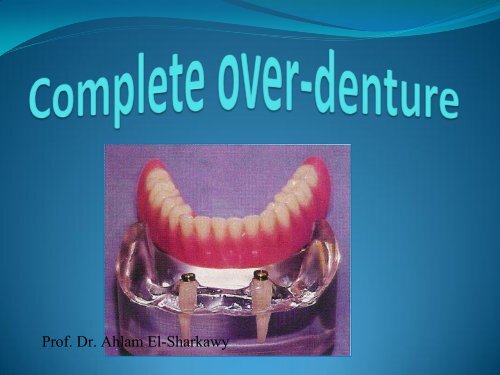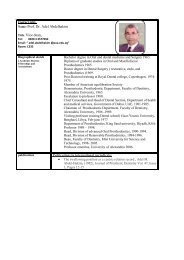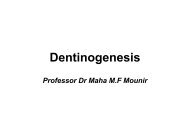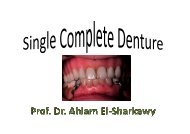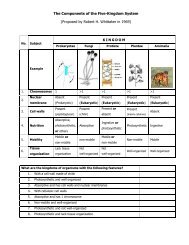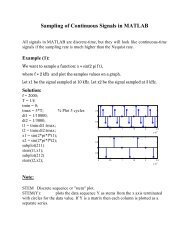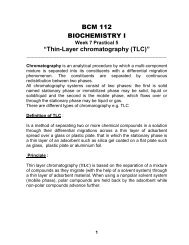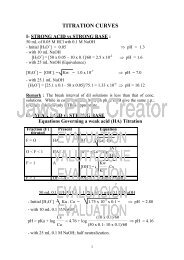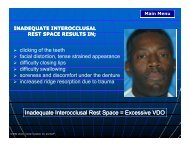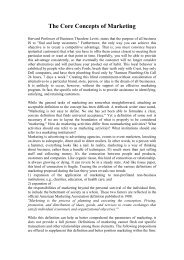Types of tooth supported Over-dentures
Types of tooth supported Over-dentures
Types of tooth supported Over-dentures
Create successful ePaper yourself
Turn your PDF publications into a flip-book with our unique Google optimized e-Paper software.
Pr<strong>of</strong>. Dr. Ahlam El-Sharkawy
Introduction<br />
• Extraction <strong>of</strong> teeth followed by continuous ridge<br />
resorption & poor denture foundation<br />
• Loss <strong>of</strong> periodontal receptors responsible for proper<br />
masticatory function & accurate jaw movements<br />
• Retention <strong>of</strong> few remaining teeth to support denture<br />
will preserve alveolar bone & preserve periodontal<br />
receptors
Definition <strong>of</strong> over<strong>dentures</strong><br />
• Complete or partial denture constructed over existing<br />
teeth, roots or implants for providing additional<br />
support, stability & retention<br />
• Called also:<br />
<strong>Over</strong>lay denture<br />
<strong>Over</strong>lay prosthesis<br />
Superimposed prosthesis
<strong>Types</strong> 0f over-Dentures.<br />
• -Tooth <strong>supported</strong> over-<strong>dentures</strong>.<br />
- Implant <strong>supported</strong> over- denture.
Pr<strong>of</strong>. Dr. Ahlam<br />
El-Sharkawy
Indications<br />
1. Cases having few hopeless teeth unsuitable as<br />
abutments for fixed or removable bridges<br />
2. Patient having few remaining teeth with periodontal<br />
disease.<br />
3. Patient with abnormal jaw size or position<br />
4. Patient with congenital or acquired defects<br />
5. Patient with single denture<br />
6. Patient exhibit flat ridges<br />
7. Pr<strong>of</strong>. Dr. Ahlam El-Sharkawy
Contraindications<br />
1. Mentally or physically handicapped<br />
2. Patient can’t be motivated to develop good oral<br />
hygiene<br />
3. Inadequate intermaxillary space<br />
4. Teeth with grade III mobility or insufficient zone <strong>of</strong><br />
attached gingiva
1- submerged roots<br />
• Abutments roots are endodontically treated .<br />
• Reduced in height to a level below gingival margin
2- dome shaped abutment with<br />
amalgam plug mmmmmm<br />
• Abutments reduced to be 1-2 mm above gingival<br />
margin to reduce lateral force & torque<br />
• Endodontic treatment is necessary<br />
• The root canal is filled with gutta percha<br />
• The opening is sealed with amalgam plug.<br />
• The abutment is contoured to attain dome- shape.<br />
• Used in patient with low caries index &good oral<br />
hygien.
3- dome shaped abutments with<br />
cast copings<br />
• Abutment are endodontically treated & reduced to 1-2<br />
mm above gingival margin<br />
• Metal dome shaped cast coping constructed to cover<br />
abutment<br />
• The metal coping has a short post cemented into root<br />
canal to retain the coping
4- abutments with telescopic<br />
crowns<br />
• Abutment teeth are either vital or endodontically<br />
treated & contoured to tapered configuration<br />
• Tapered metal copings constructed &cemented over<br />
abutments<br />
• Denture constructed with metal crowns having<br />
veneered facings
5- abutments with slight <strong>tooth</strong><br />
reduction & cast copings<br />
• Abutments are minimally reduced<br />
• With or without endo treatment<br />
• Covered with cast metal coping “long coping<br />
abutment”. This type is rarely followed because it<br />
• requires adequate ridge space
6- abutments with simple<br />
reduction & slight modification<br />
• Abutments slightly reduced & contoured to eliminate<br />
undercuts<br />
• Rarely used, cases with partial anodontia or enough<br />
inter ridge space
7- abutments with an added form<br />
<strong>of</strong> attachment<br />
• Endodontically treated, reduced & covered with metal<br />
coping<br />
• Coping has a long post to help retention<br />
• Attachment added either by soldering or during wax<br />
pattern
<strong>Types</strong> <strong>of</strong> <strong>tooth</strong> <strong>supported</strong> <strong>Over</strong>-<strong>dentures</strong><br />
1. Immediate over-denture<br />
2. Interim over-denture<br />
3. Remote or definitive over-denture<br />
4. Attachment retained over-denture
Immediate overdenture<br />
• Constructed prior to preparation <strong>of</strong> abutment teeth &<br />
ready for insertion after preparation& reduction<br />
• It enhances patient’s ability & adaptability to wear<br />
<strong>dentures</strong>
Interim overdenture<br />
• Used for patients in transition or preparation phase<br />
until permanent overdenture constructed<br />
• Patient old partial denture can be modified & used by<br />
extending the denture & add new artificial teeth using<br />
self cure acrylic resin
Remote or definitive over-denture<br />
• Conventional complete over-denture constructed over<br />
1 or more abutment teeth<br />
• Could be made entirely <strong>of</strong> acrylic resin or in<br />
conjunction with metal bases
Attachment retained over-denture<br />
• Constructed with an incorporated attachment to<br />
improve retention<br />
• More expensive & more time for construction<br />
• Indicated for patient with good oral hygiene & low<br />
caries index<br />
• The abutment teeth should have good periodontal<br />
condition & adequate bone support
<strong>Types</strong> <strong>of</strong> Attachments<br />
a) Rigid attachment<br />
Doesn’t allow movement <strong>of</strong> denture base<br />
Provide adequate retention<br />
May induce more torque on abutment<br />
b) Resilient attachment<br />
Allows some control <strong>of</strong> movements.<br />
Induces less torque on abutments.
<strong>Over</strong>-Denture Attachment<br />
could be in the form <strong>of</strong>:<br />
• 1- Stud Attachments.<br />
• 2- Bar attachments.<br />
• 3 Magnetic Attachments.
• Consists <strong>of</strong> 2 parts<br />
1- Stud attachment<br />
The stud usually attached to metal coping cemented<br />
over prepared abutment<br />
Housing embedded in the fitting surface <strong>of</strong> overdenture
1- Stud attachment<br />
• Extra-Radicular : The stud is attached to the metal<br />
coping cemented over the prepared abutment, while<br />
the housing is embedded in the fitting surface <strong>of</strong> the<br />
denture. e.g : Ceka , Rotherman, Gerber
1- Stud attachment<br />
B- Intra-Radicular: The stud is attached to the fitting<br />
surface <strong>of</strong> the denture and the housing is incorporated<br />
in the abutment. e.g : Zest Anchor<br />
• eg
2-Bar attachment<br />
• A bar contoured to connect abutment teeth together ,<br />
run parallel & overlie residual ridge<br />
• Provide support & retention for overdenture & splint<br />
abutment teeth<br />
• Bars may be in form <strong>of</strong> preformed metal or plastic
A- Bar units<br />
• Rigidly fixed to copings, don’t allow any movement<br />
between bar & sleeve<br />
• Transmits occlusal stresses totally to abutments “<strong>tooth</strong><br />
born”
B- Bar joints<br />
• Resilient attachments allowing movement between<br />
bar & sleeve<br />
• Support provided by both residual ridge & abutment<br />
teeth “<strong>tooth</strong> tissue born”
3- magnetic attachments<br />
• Small, strong mini magnets<br />
• One <strong>of</strong> poles cemented in a prepared cavity in<br />
endodontically treated abutment & the other attached<br />
to denture base


